| کد مقاله | کد نشریه | سال انتشار | مقاله انگلیسی | نسخه تمام متن |
|---|---|---|---|---|
| 782320 | 1464993 | 2014 | 13 صفحه PDF | دانلود رایگان |

• We study power-law damping under multiaxial stress, assuming elasto-plastic microscopic flaws.
• Ellipsoidal flaws are studied using ABAQUS as well as Eshelby׳s formulas, with a perfect match.
• Two limits, spherical flaws and thin and flat flaws, are considered in detail.
• Weibull-distributed flaw strengths and random orientations of thin flaws are assumed.
• Net average cyclic dissipation is, surprisingly, governed by distortional energy in both cases.
Internal energy dissipation in many materials, per stress cycle and per unit volume, is frequency-independent and proportional to some power of an equivalent stress amplitude, σeqm. For triaxial stress states, the definition of σeqσeq has so far been ad hoc. In this paper a micromechanically motivated constitutive model for such internal dissipation is developed by assuming a multitude of dispersed microscopic ellipsoidal elasto-plastic flaws. Both detailed ABAQUS simulations and a semi-analytical approach based on formulas given by Eshelby are used. Two limiting special cases are identified where the dissipation in a single flaw is analytically tractable: spherical flaws, and flaws that are flat and thin. For these, Weibull-distributed flaw strengths and spatially homogeneously distributed flaws are assumed. Formulas for the macroscopic dissipation are obtained, analytically for spherical flaws and semi-analytically for flat and thin flaws. For spherical flaws, the averaged macroscopic dissipation is exactly equal to a power of the distortional strain energy. For flat and thin flaws, for 2≤m≤62≤m≤6, the overall dissipation is closely, but not exactly, described by a power of the distortional strain energy alone, even though the dissipation in individual flaws is not governed by distortional strain energy.
Journal: International Journal of Mechanical Sciences - Volume 87, October 2014, Pages 137–149